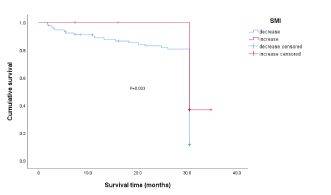Association between pre- and post-transplant nutritional indices and skeletal muscle mass with 5-year survival after liver transplantation: A retrospective study
Ya-Tzu Tsao1, I-Hsin Tseng1, Shih-Wei Nien1, I-Hsin Lin1.
1Department of Medical Nutrition Therapy, Chang Gung Memorial Hospital at Linkou, Taoyuan, Taiwan
Introduction: Liver transplantation is a life-saving treatment option for patients with end-stage liver disease. The postoperative outcomes of liver transplant recipients are influenced by various factors, including nutritional status. Previous research has shown that parameters such as the Prognostic Nutritional Index (PNI) and Skeletal Muscle Index (SMI) are associated with post-transplant survival in liver transplant recipients. However, there is limited research specifically examining the association between PNI and SMI changes and post-transplant survival outcomes in liver transplant recipients. Understanding the relationship between PNI and SMI changes and post-transplant survival is crucial for optimizing patient care and improving transplant outcomes. Therefore, the present study aims to investigate the impact of PNI and SMI changes on post-transplant survival in liver transplant recipients.
Method: A total of 114 liver transplant recipients were included in this retrospective study. Preoperative and postoperative PNI and SMI measurements were obtained for each patient. Kaplan-Meier survival analysis was conducted to assess the impact of SMI changes on post-transplant survival, stratified by PNI changes. The log-rank test was used to compare survival curves between different groups. Cox regression analysis was performed to identify independent predictors of post-transplant survival.
Results: The results revealed that changes in SMI were significantly associated with post-transplant survival outcomes in liver transplant recipients, particularly when stratified by changes in PNI. Kaplan-Meier survival curves demonstrated that patients with both increased PNI and SMI exhibited significantly higher post-transplant survival rates compared to those with decreased PNI and SMI. Additionally, the log-rank test showed a statistically significant difference in survival curves between different SMI change groups (χ²=8.960, df=1, p=0.003). Cox regression analysis identified SMI changes as an independent predictor of post-transplant survival after adjusting for potential confounding factors.

Conclusion: Our study highlights the importance of assessing changes in both PNI and SMI as prognostic indicators for post-transplant survival in liver transplant recipients. Monitoring nutritional status and skeletal muscle mass changes before and after liver transplantation may help identify patients at higher risk of poor outcomes and guide targeted interventions to improve post-transplant survival. Further prospective studies are warranted to validate these findings and elucidate the underlying mechanisms linking nutritional status and skeletal muscle mass with post-transplant outcomes.
[1] Liver Transplantation
[2] Prognostic Nutrition Index
[3] Skeletal Muscle Index
[4] Survival
